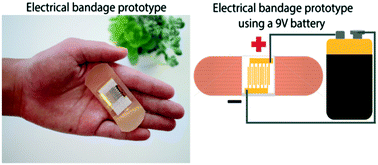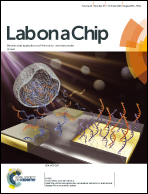Interdigitated microelectronic bandage augments hemostasis and clot formation at low applied voltage in vitro and in vivo†
Abstract
Hemorrhage or uncontrolled bleeding can arise either due to a medical condition or from a traumatic injury and are typically controlled with the application of a hemostatic agent. Hemostatic agents are currently derived from animal or human products, which carry risks of blood borne infections and immune dysregulation. Therefore, the need exists for novel biomedical therapies not derived from animal or human products to achieve hemostasis. Accordingly, we created an interdigitated microelectronic bandage that applies low voltage electrical stimulation to an injury site, resulting in faster clot formation without excessive heating, accelerated fibrin formation, and hemostasis overall. Our interdigitated microelectronic bandage found fibrin formed 1.5× faster in vitro. In vivo, total cessation of bleeding was 2.5× faster, resulting in 2× less blood loss. Electricity has been used in medical applications such as defibrillation, cauterization, and electrosurgery, but scant research has focused on hemostasis. Here we report a novel surface treatment using an interdigitated microelectronic device that creates rapid hemostasis in both in vitro and in vivo bleeding models with low applied voltages, representing a new and novel class of hemostatic agents that are electrically-based.

- This article is part of the themed collection: Lab on a Chip Pioneers of Miniaturization Lectureship winners


 Please wait while we load your content...
Please wait while we load your content...
